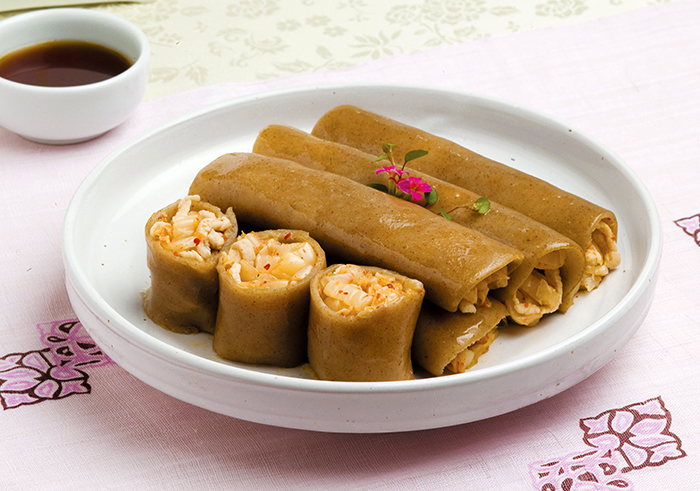
Buckwheat pancakes, or memil chongtteok, are made from buckwheat grown mostly in Gangwon, Pyeongan or Hamgyeong provinces. It's a well-known local delicacy.
Known for its light and clear taste accompanied by a savory smell, buckwheat is one of the most popular grains and ingredients in Korean cuisine.
Buckwheat is mainly grown in the northern areas of the Korean Peninsula, in the regions of Gangwon, Pyeongan and Hamgyeong. Many popular dishes include buckwheat noodles, or memil guksu, and rolled pancakes -- or memil chongtteok, also known as memil jeonbyeong -- are one of the most delicious.
Buckwheat noodles are especially popular as an official coming-of-age dish. During Joseon times (1392-1910), a host would serve the dish as lunch to guests after the coming-of-age ceremony, or gwanje (관제, 冠禮), was held, one of the four ceremonial milestones of life.
There are records concerning buckwheat in the "Eumsik Dimibang" (음식 디미방, 飮食 知味方), the first cookbook written in Korean and put together by a daughter-in-law in an aristocratic yangban family. The book referred to the noodles made from powdered buckwheat simply as “noodles,” or myeon (면, 麵), showing just how common buckwheat noodles were at that time.
Many people enjoy buckwheat noodles, especially during hot weather. However, it is also loved during cold weather. The dish is recorded as being a dish eaten in October in the "Nongga Wollyeongga," or "Song of Famers" (농가월령가, 農家月令歌), a book about monthly events and folk customs among Joseon farming families.
Rolled buckwheat pancakes, or memil chongtteok, are another popular dish made from buckwheat. They're made from powdered buckwheat for the pancakes and then radish, cabbage kimchi and pork for the filling. Chives, shitake mushrooms and beef can be used, too, depending on the region.
Buckwheat is not only tasty, but also healthy. In the "Dongui Bogam" (동의 보감, 東醫 寶鑑), the best-known Joseon medical book, the author Heo Jun (허준, 許浚) (1546-1615) said, “Buckwheat reduces chills and the heat in the stomach. Once eaten, it relieves symptoms of indigestion even if they have lasted throughout the year.”
Some studies show that buckwheat helps with detoxification functions in the liver.
It helps the liver to discharge body waste that has accumulated in the liver. Also, it helps people recover from a hangover, as it functions as an alcohol detoxifier.
Buckwheat boosts urination and defecation activities, reduces blood cholesterol and helps to prevent any hardening of the arteries. It's also good for the skin and helps to treat skin irritations, such as furunculus on the head or boils on the skin.
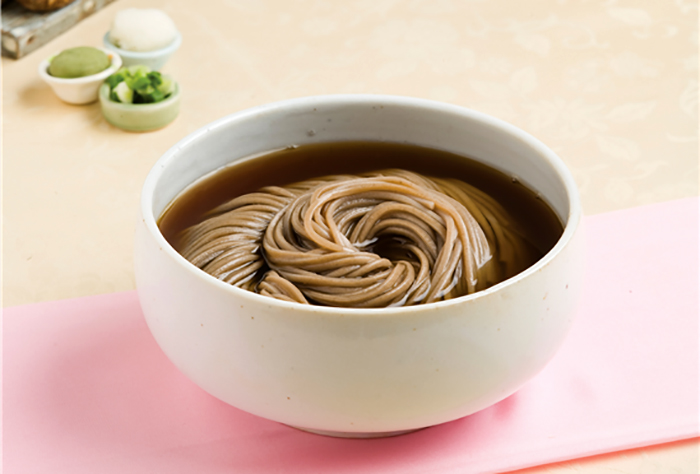
Buckwheat noodle is a popular dish, especially during hot weather. It's known for its light and clear taste and it helps with digestion, too.
Buckwheat noodle soup
** Ingredients
80 grams of fresh noodles made from buckwheat
For the soup:
30 grams of anchovy stock
4 pieces of dried shitake mushroom
10 grams of kelp
5 cups of water
1 cup of refined rice wine
50 grams of dried bonito flakes
2 tablespoons of soy sauce
1 teaspoon of sugar
100 grams of cucumber 100 grams of radish
20 grams of green onion
20 grams of horseradish paste
** Recipe
1. Trim the anchovies by removing the heads and inner organs. Quickly wash the dried shitake mushrooms in water and drain them. Rub the kelp with a wet cloth.
2. Boil the anchovies in water over a medium heat for 2 minutes. Add more water, the refined rice wine, shitake mushrooms and kelp and boil it all together for 10 minutes. Turn off the heat and add the dried bonito flakes and leave it for 20 minutes. Drain it all through a fine strainer. Add the soy sauce and sugar for flavor.
3. Finely shred the cucumber into 5-centimeter lengths. Grind the radish with a grater. Chop the green onions.
4. Cook the noodles in boiling water. Rinse the cooked noodles in cold, running water. Put them in a bowl of ice water. Remove the noodles and roll them into balls.
5. Put the noodles and the soup into a bowl. Serve the dish with the shredded cucumber, ground radish, green onions and horseradish paste.
Buckwheat rolled pancakes
** Ingredients
90 grams or 1/2 cup of powdered buckwheat
1 gram or 1/4 teaspoon of salt
175 grams or 3/4 cup of water
100 grams of pork sirloin
Marinade:
1/2 teaspoon of soy sauce
1/2 teaspoon of minced garlic
1/8 teaspoon of ground pepper
100 grams of cabbage kimchi
1/2 teaspoon of sesame oil
1/2 teaspoon of sesame salt
2 tablespoons of canola oil
Dipping sauce:
1 tablespoon of soy sauce
1 tablespoon of vinegar
1 tablespoon of water
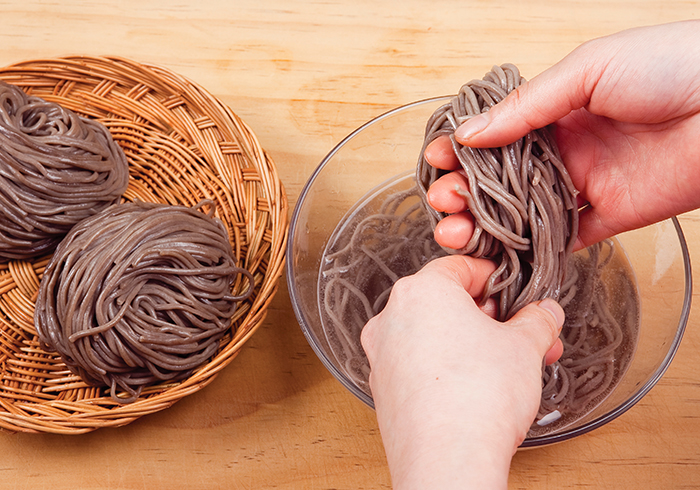
Cook the buckwheat noodles in boiling water and rinse them in icy water.
** Recipe
1. Heat the pan with canola oil. Fry the pork over a low heat for 2 minutes.
2. Make the filling with the pork and kimchi.
3. Preheat the pan with canola oil. Make round pancakes about 10 centimeters in diameter, with a thickness of about 2 millimeters. Cook the pancakes over a low heat for about 30 seconds per side. Place the filling on each of the pancakes and roll them into pancake rolls.
4. Cool the rolled pancakes and cut them into 5-centimeter lengths. Serve them with the dipping sauce.
Managed by Yoon Sojung
Korea.net Staff Writer
In cooperation with the Institute of Traditional Korean Food (ITKF)
Recipe from “The Beauty of Korean Food: 100 Best-Loved Recipes”
arete@korea.kr
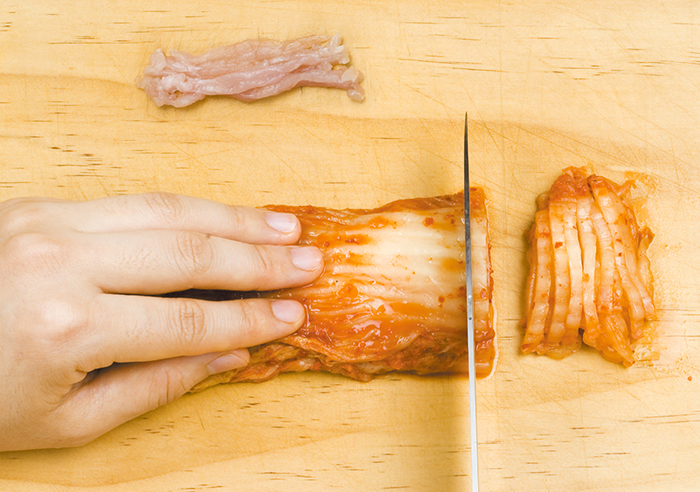
Cut the cabbage kimchi and pork to make the filling for the buckwheat rolled pancakes. Shredded radish kimchi or bean sprouts can also be used.
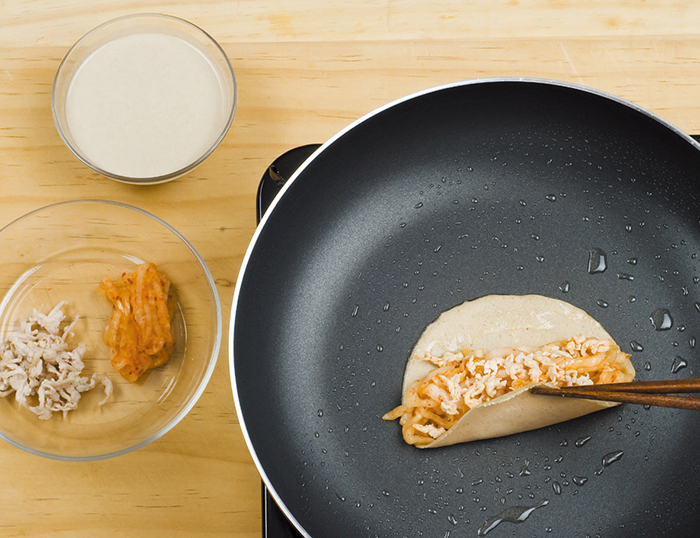
Cook the pancakes in a preheated frying pan over a low heat. Be sure to make very thin pancakes so as to have a better texture. Place the filling on the pancake, roll it up and cook it in the pan.